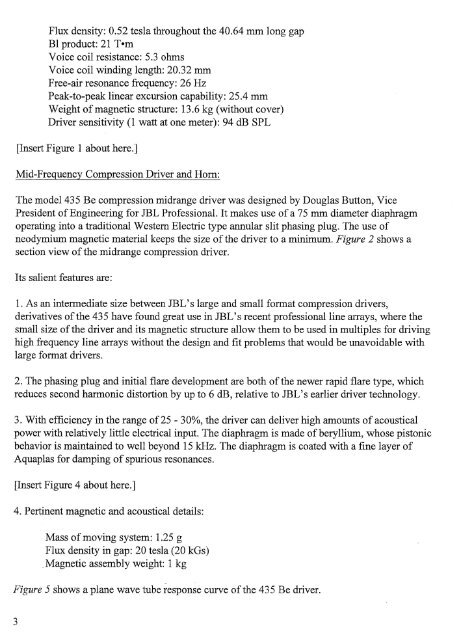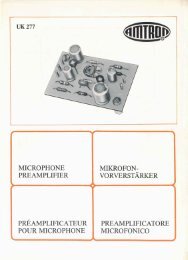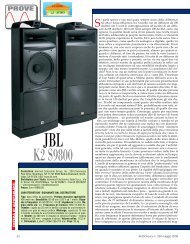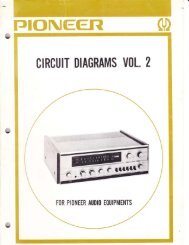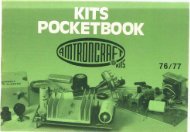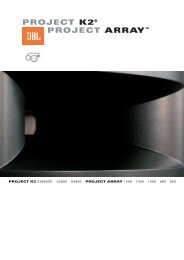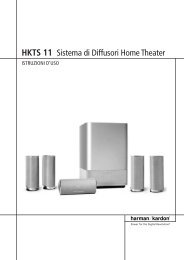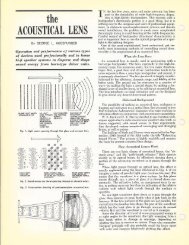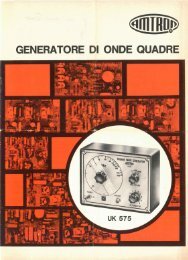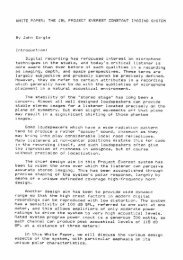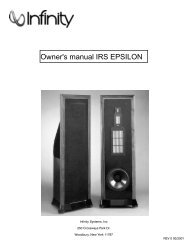JBL - K2 S9800 - White Paper (english) (2001).
JBL - K2 S9800 - White Paper (english) (2001).
JBL - K2 S9800 - White Paper (english) (2001).
You also want an ePaper? Increase the reach of your titles
YUMPU automatically turns print PDFs into web optimized ePapers that Google loves.
Flux density: 0.52 tesla throughout the 40.64 mm long gap<br />
Bl product: 21 T»m<br />
Voice coil resistance: 5.3 ohms<br />
Voice coil winding length: 20.32 mm<br />
Free-air resonance frequency: 26 Hz<br />
Peak-to-peak: linear excursion capability: 25.4 mm<br />
Weight of magnetic structure: 13.6 kg (without cover)<br />
Driver sensitivity (1 watt at one meter): 94 dB SPL<br />
[Insert Figure 1 about here.]<br />
Mid-Frequency Compression Driver and Horn:<br />
The model 435 Be compression midrange driver was designed by Douglas Button, Vice<br />
President of Engineering for <strong>JBL</strong> Professional. It makes use of a 75 mm diameter diaphragm<br />
operating into a traditional Western Electric type annular slit phasing plug. The use of<br />
neodymium magnetic material keeps the size of the driver to a minimum. Figure 2 shows a<br />
section view of the midrange compression driver.<br />
Its salient features are:<br />
1. As an intermediate size between <strong>JBL</strong>'s large and small format compression drivers,<br />
derivatives of the 435 have found great use in <strong>JBL</strong>'s recent professional line arrays, where the<br />
small size of the driver and its magnetic structure allow them to be used in multiples for driving<br />
high frequency line arrays without the design and fit problems that would be unavoidable with<br />
large format drivers.<br />
2. The phasing plug and initial flare development are both of the newer rapid flare type, which<br />
reduces second harmonic distortion by up to 6 dB, relative to <strong>JBL</strong>'s earlier driver technology.<br />
3. With efficiency in the range of 25 - 30%, the driver can deliver high amounts of acoustical<br />
power with relatively little electrical input. The diaphragm is made of beryllium, whose pistonic<br />
behavior is maintained to well beyond 15 kHz. The diaphragm is coated with a fine layer of<br />
Aquaplas for damping of spurious resonances.<br />
[Insert Figure 4 about here.]<br />
4. Pertinent magnetic and acoustical details:<br />
Mass of moving system: 1.25 g<br />
Flux density in gap: 20 tesla (20 kGs)<br />
. Magnetic assembly weight: 1 kg<br />
Figure 5 shows a plane wave tube response curve of the 435 Be driver.<br />
3


